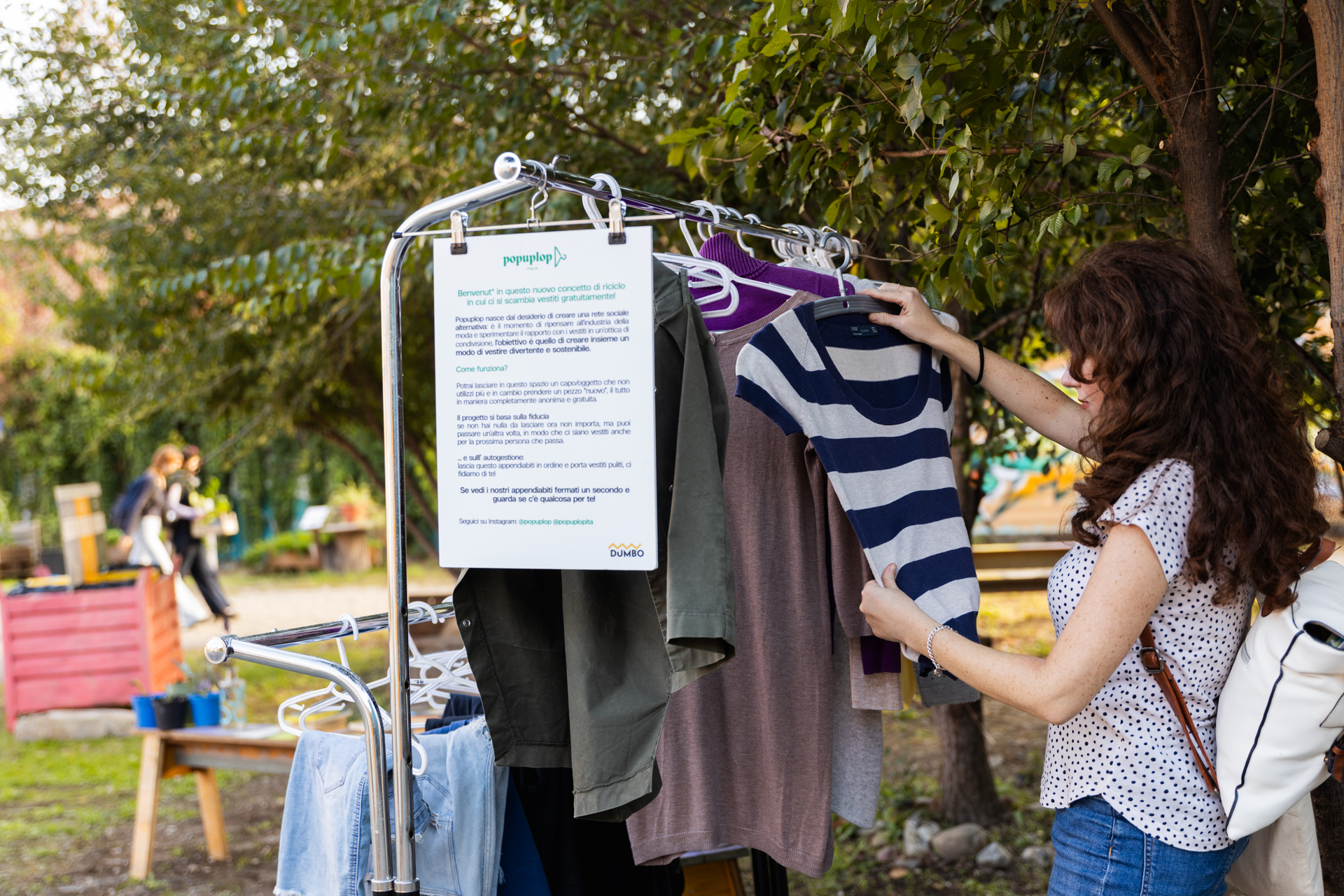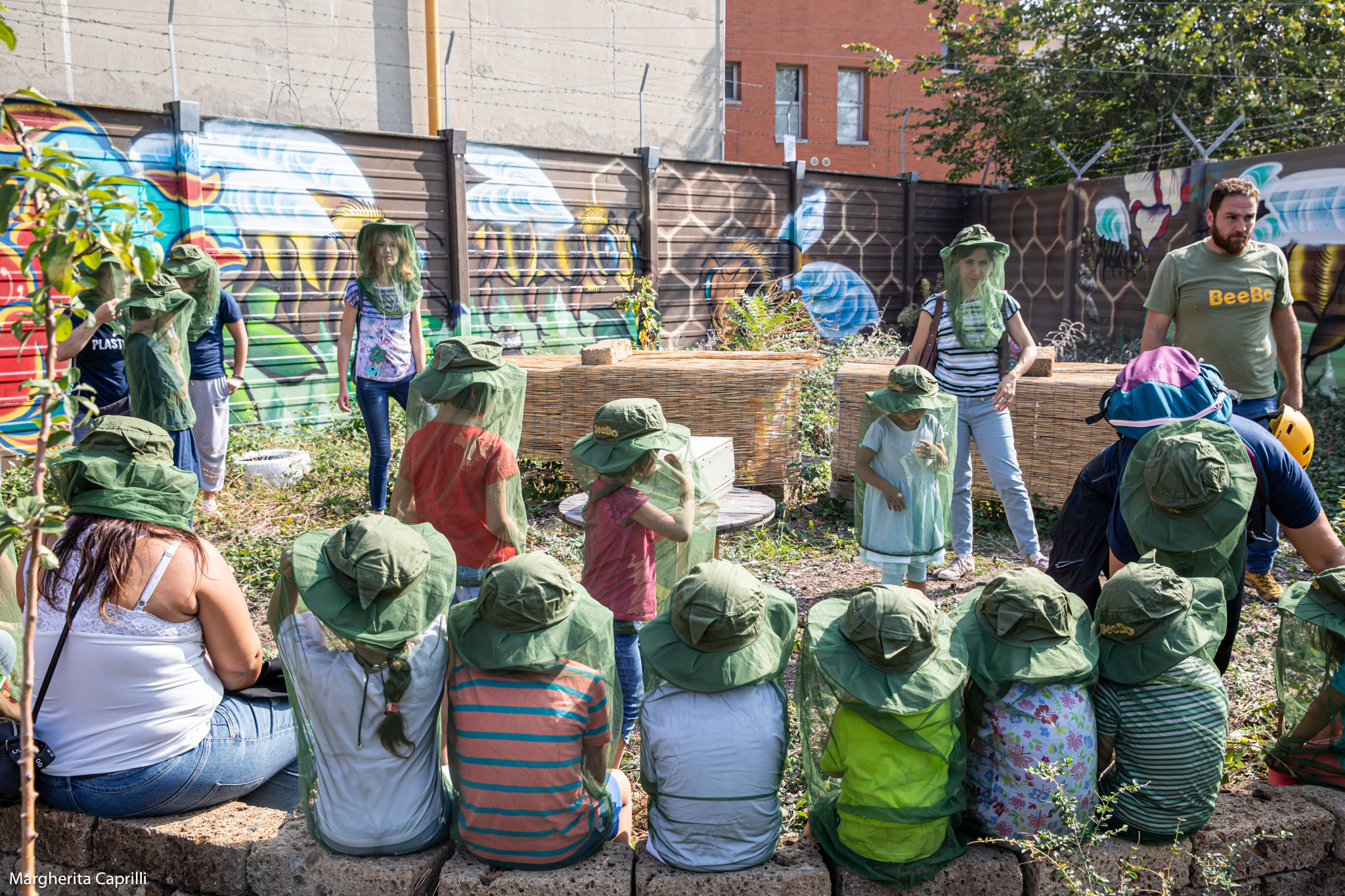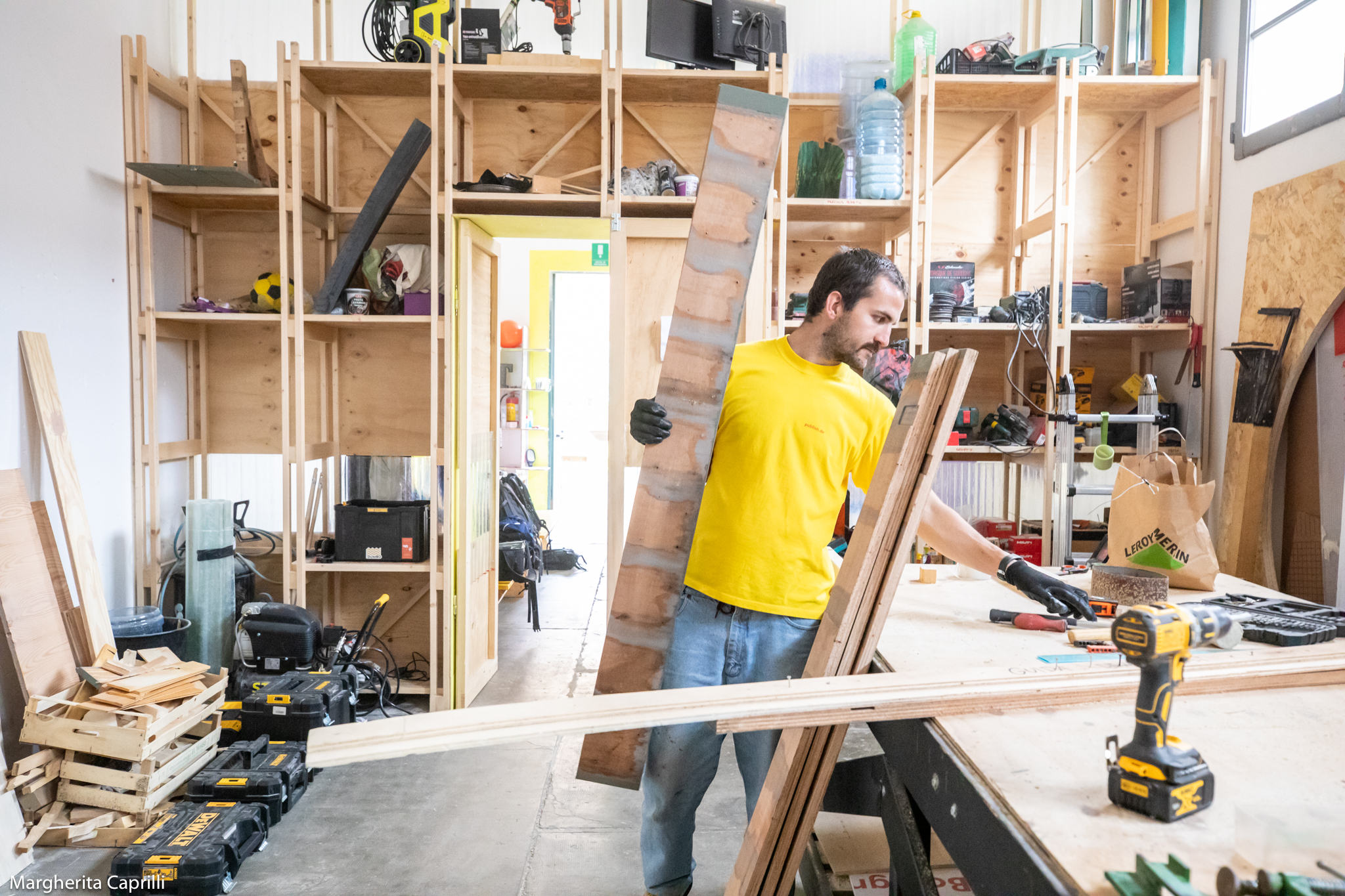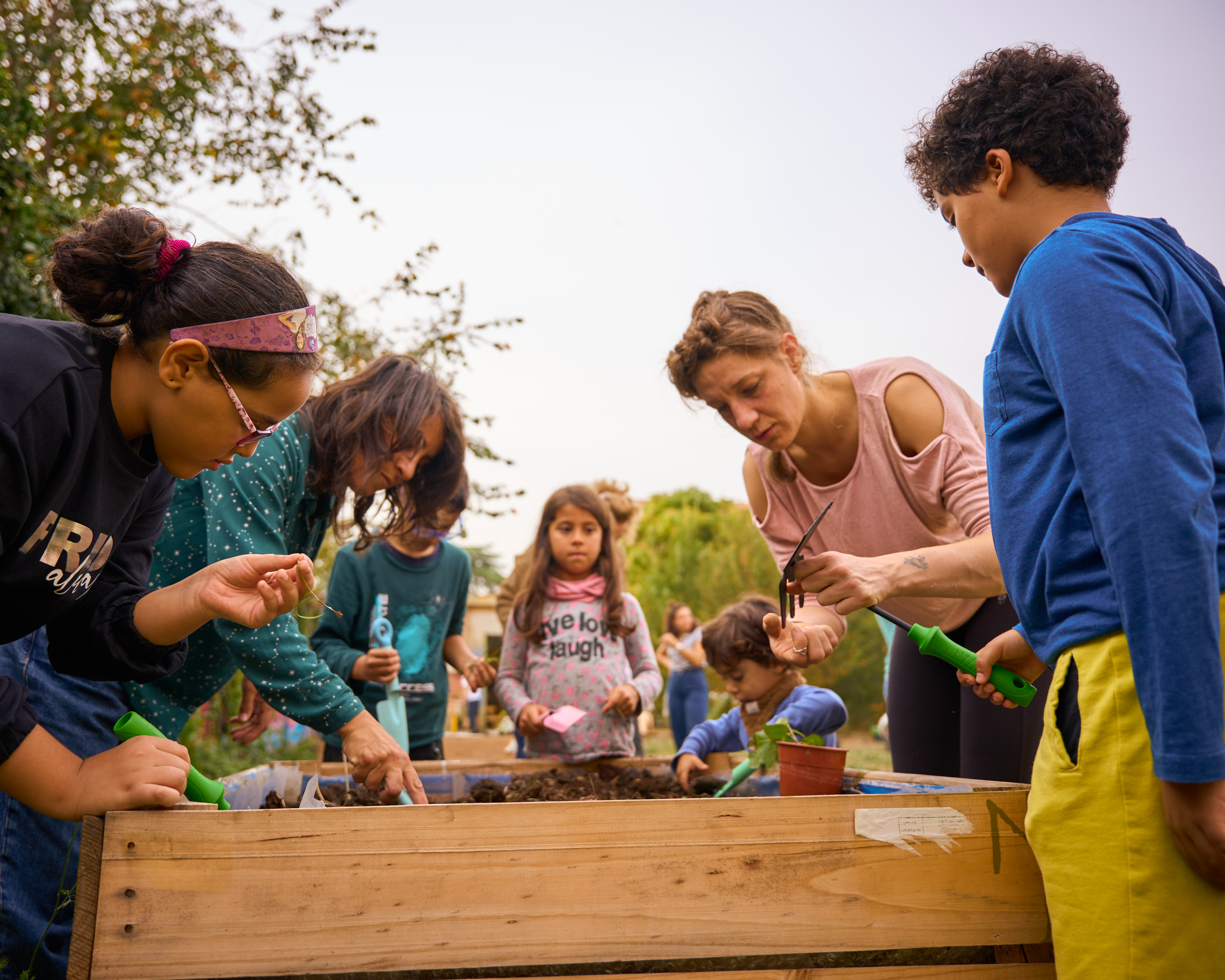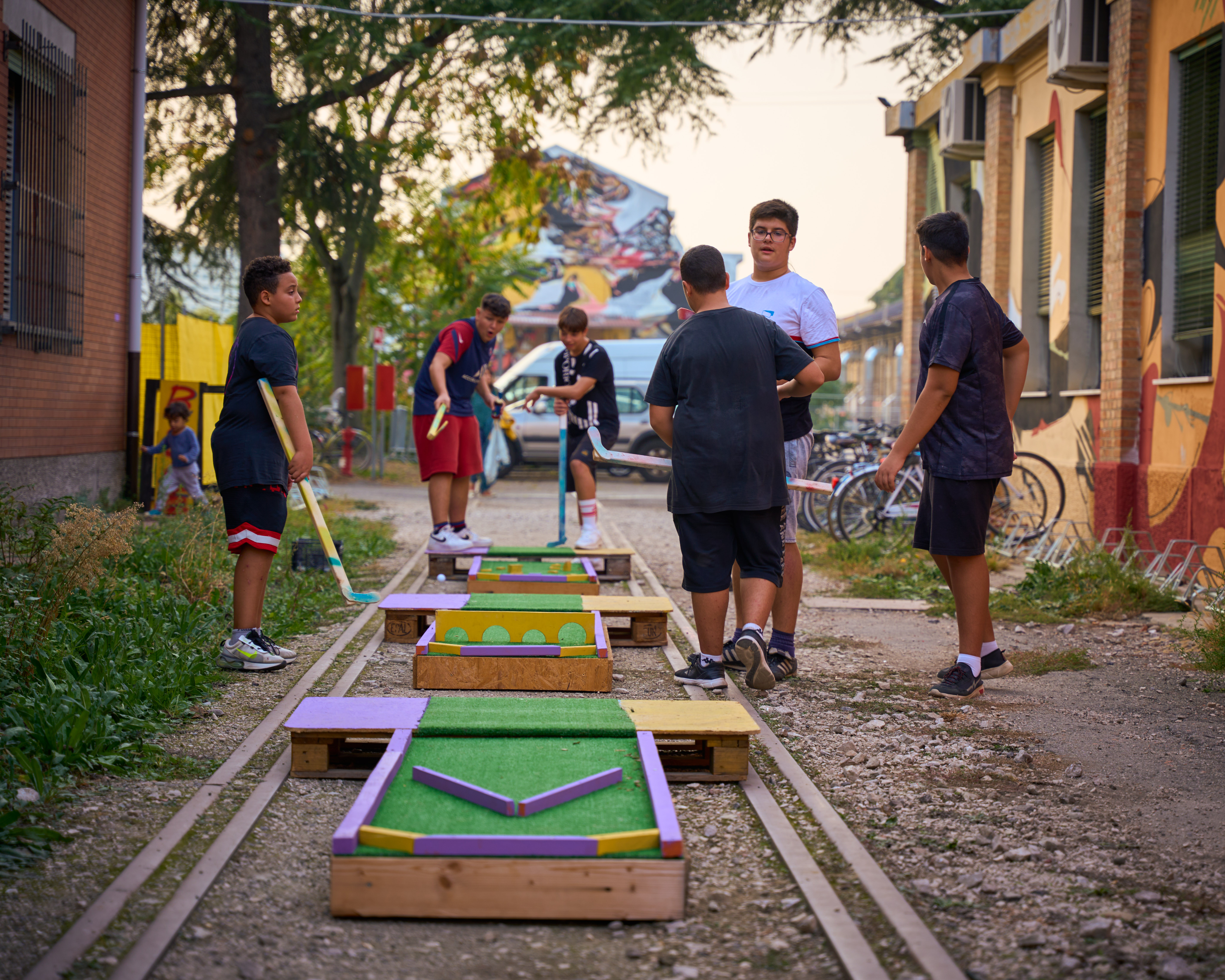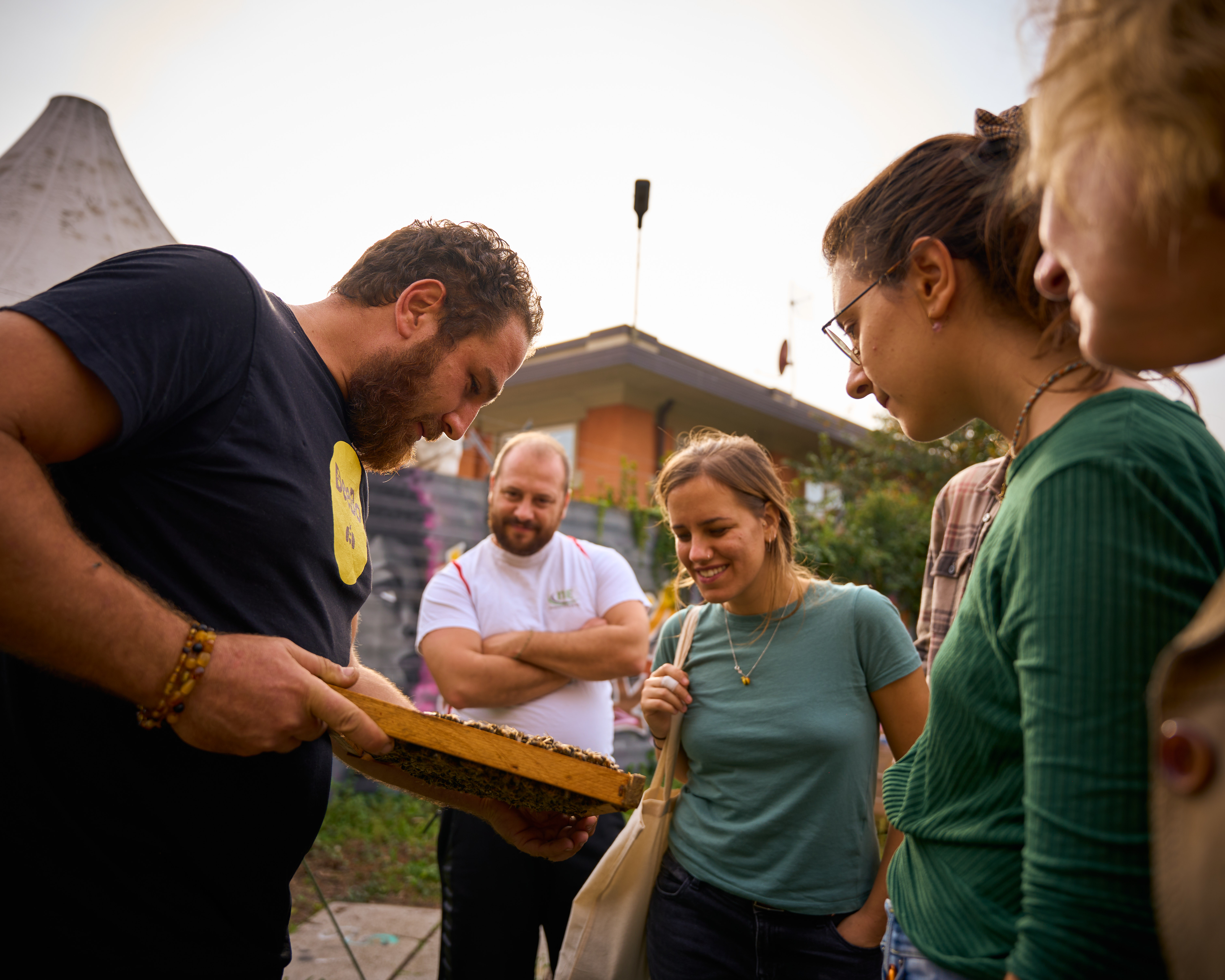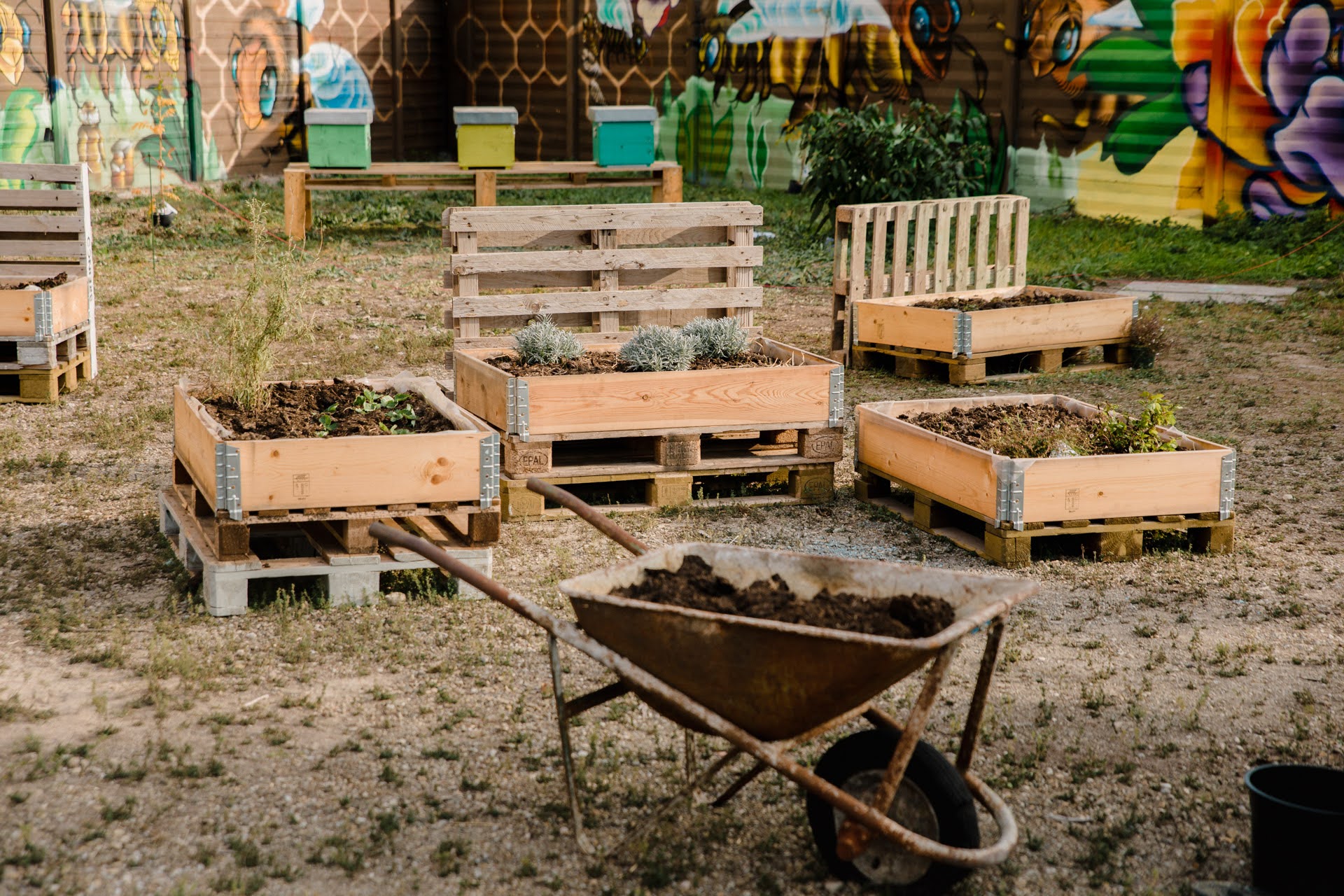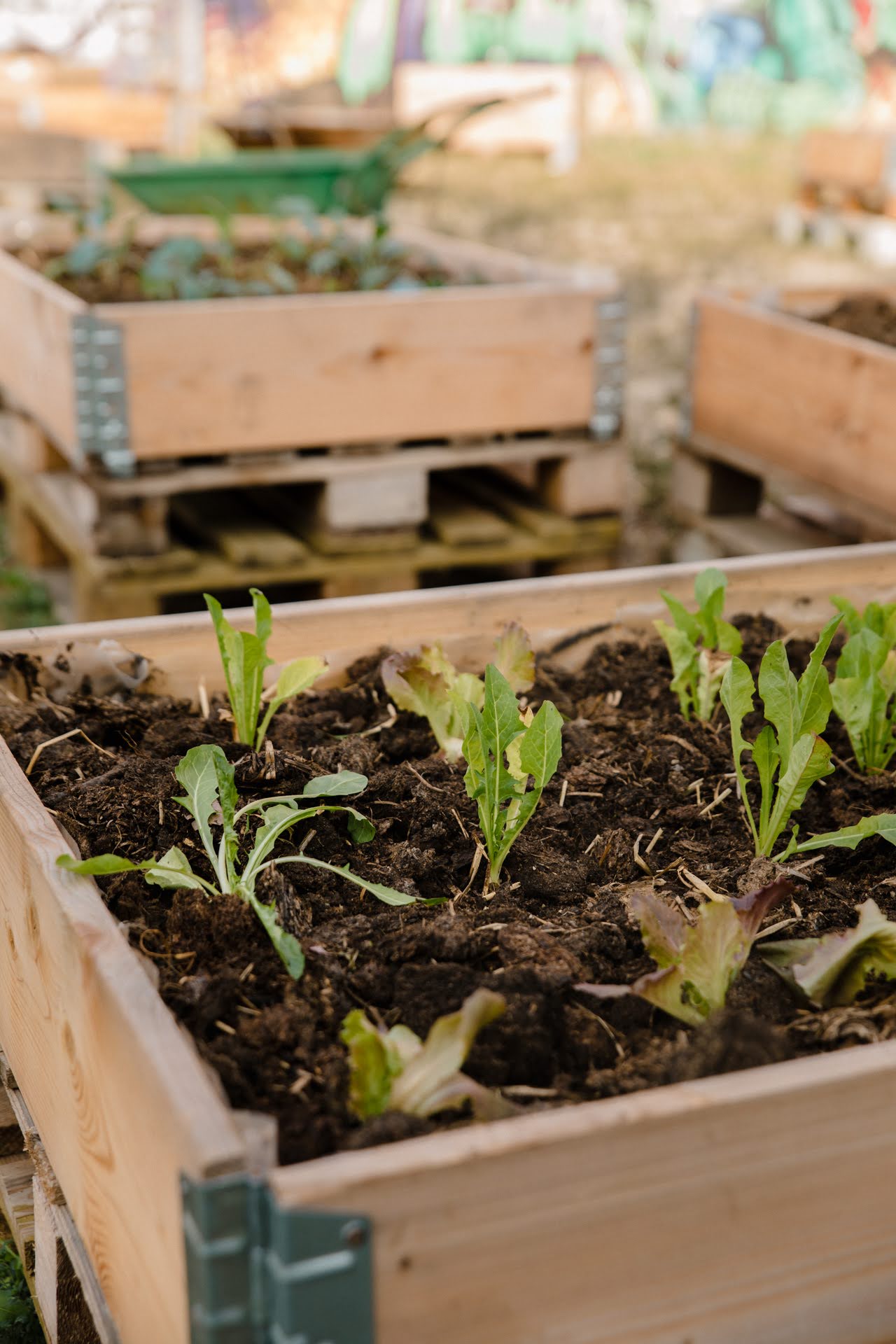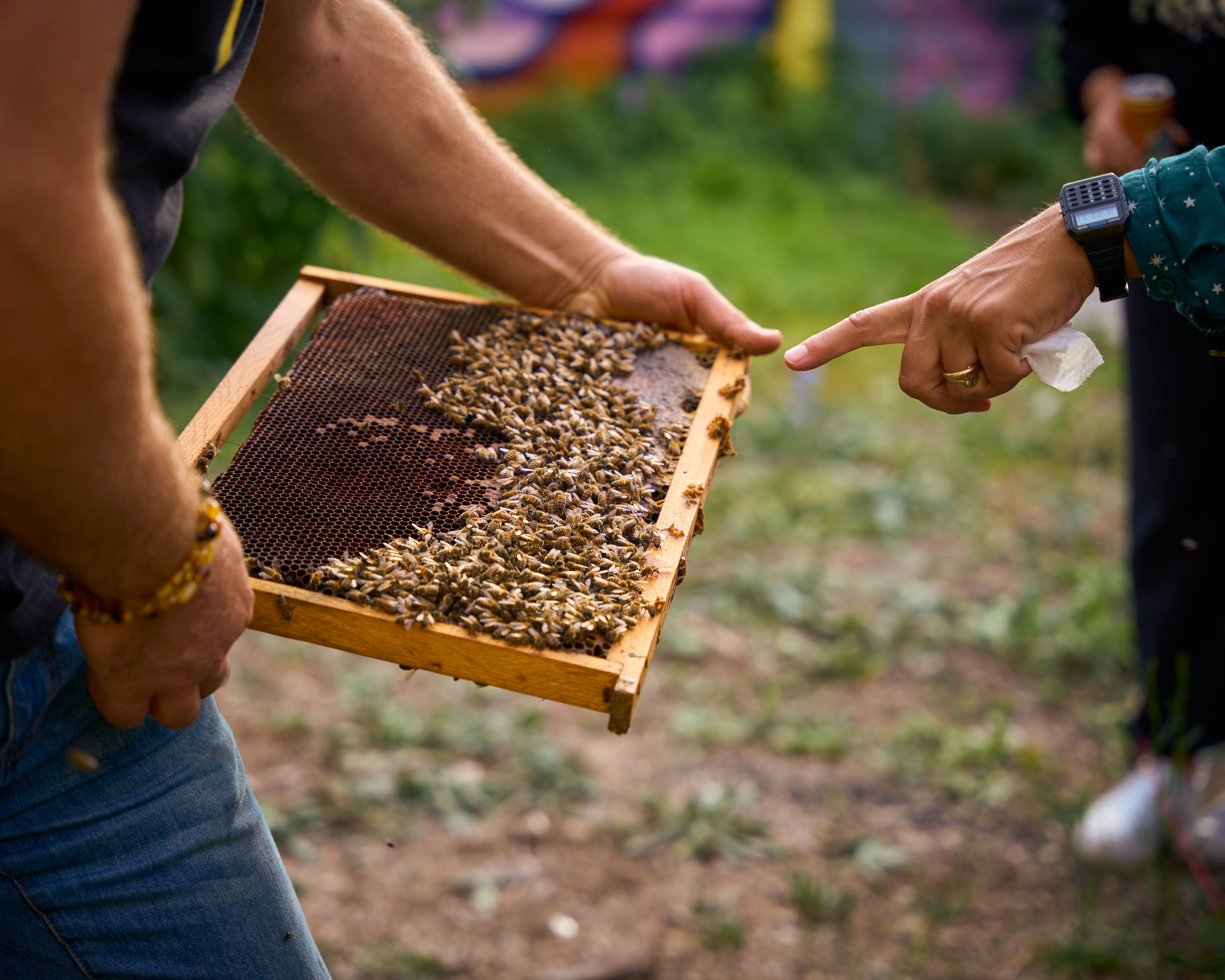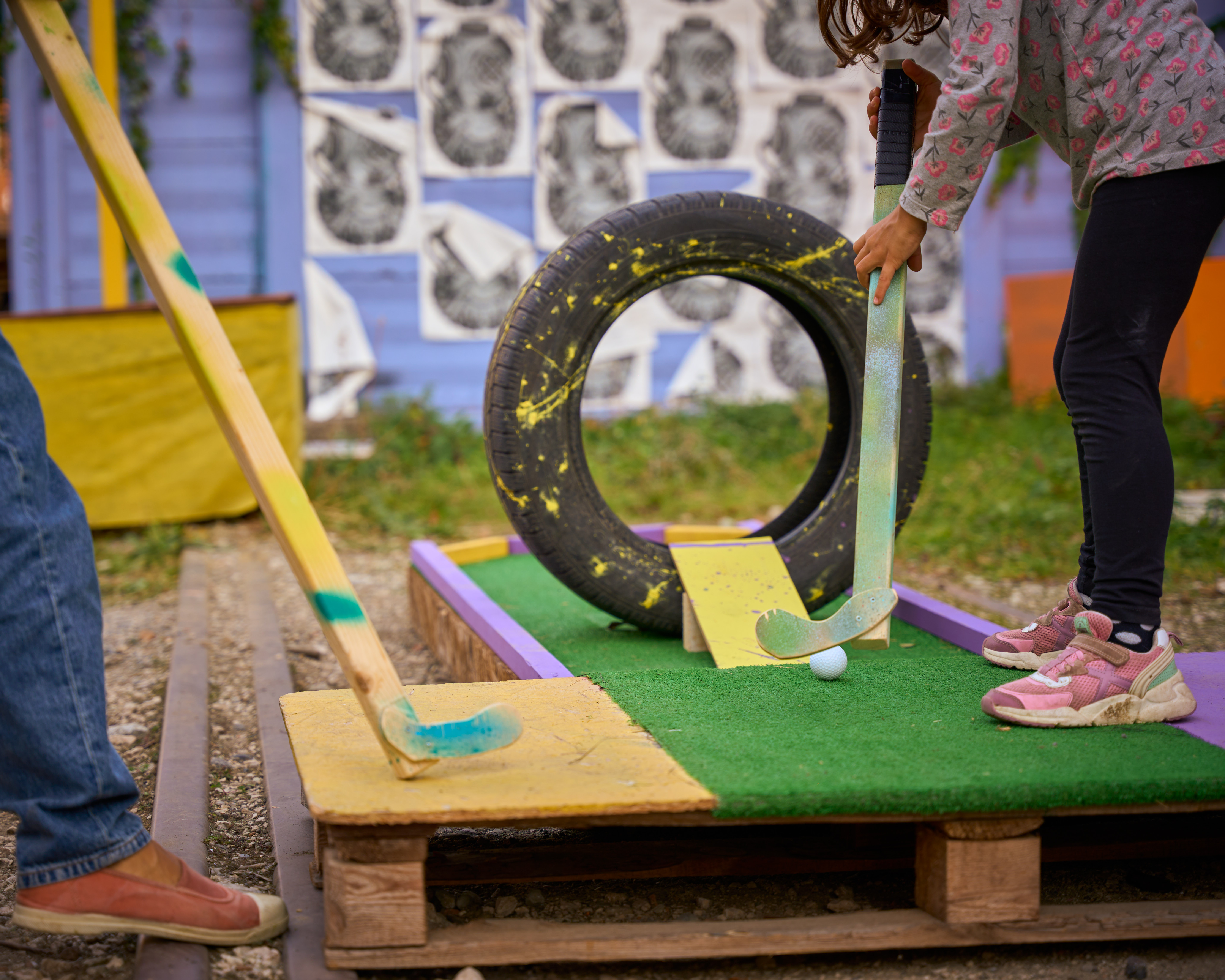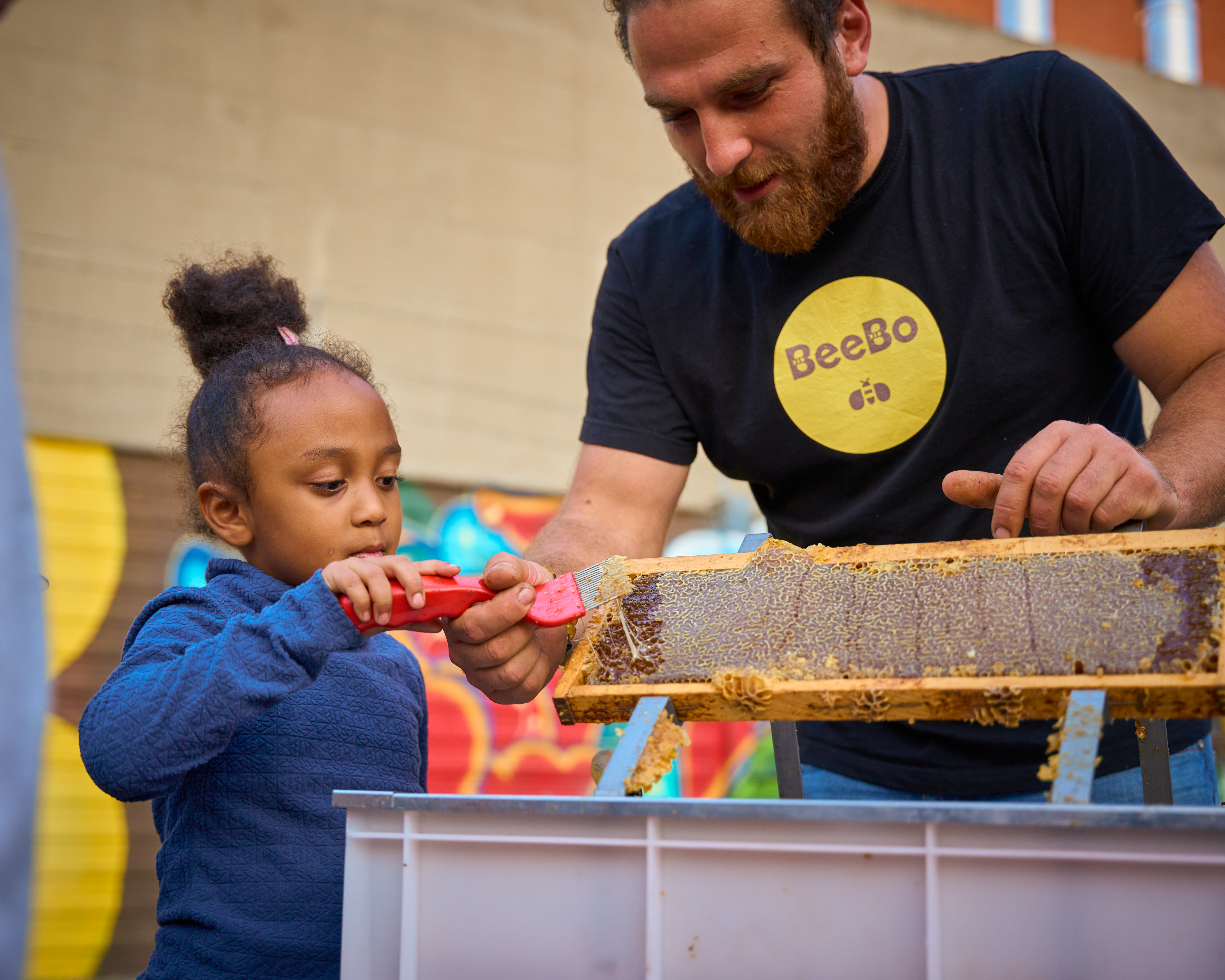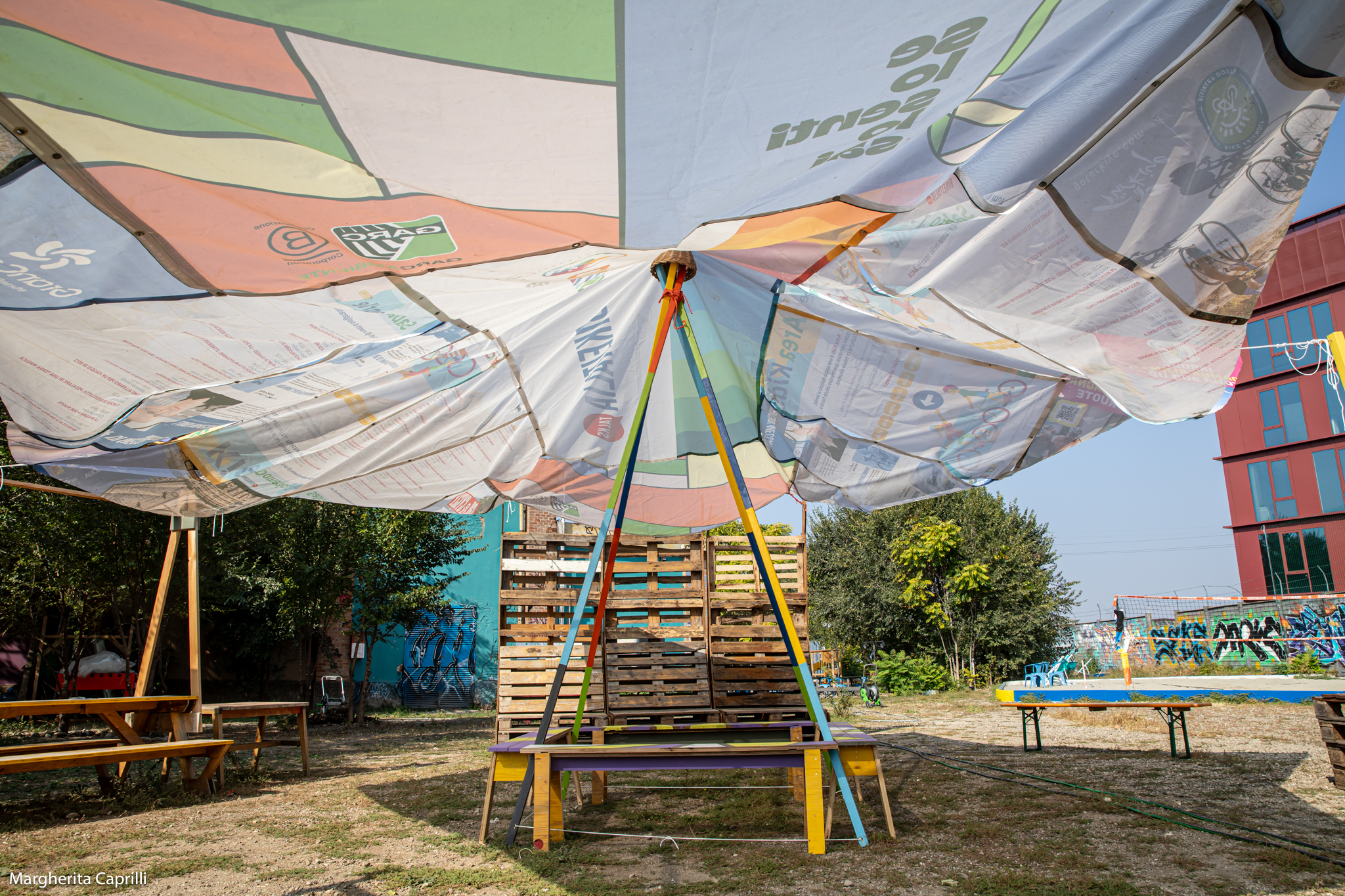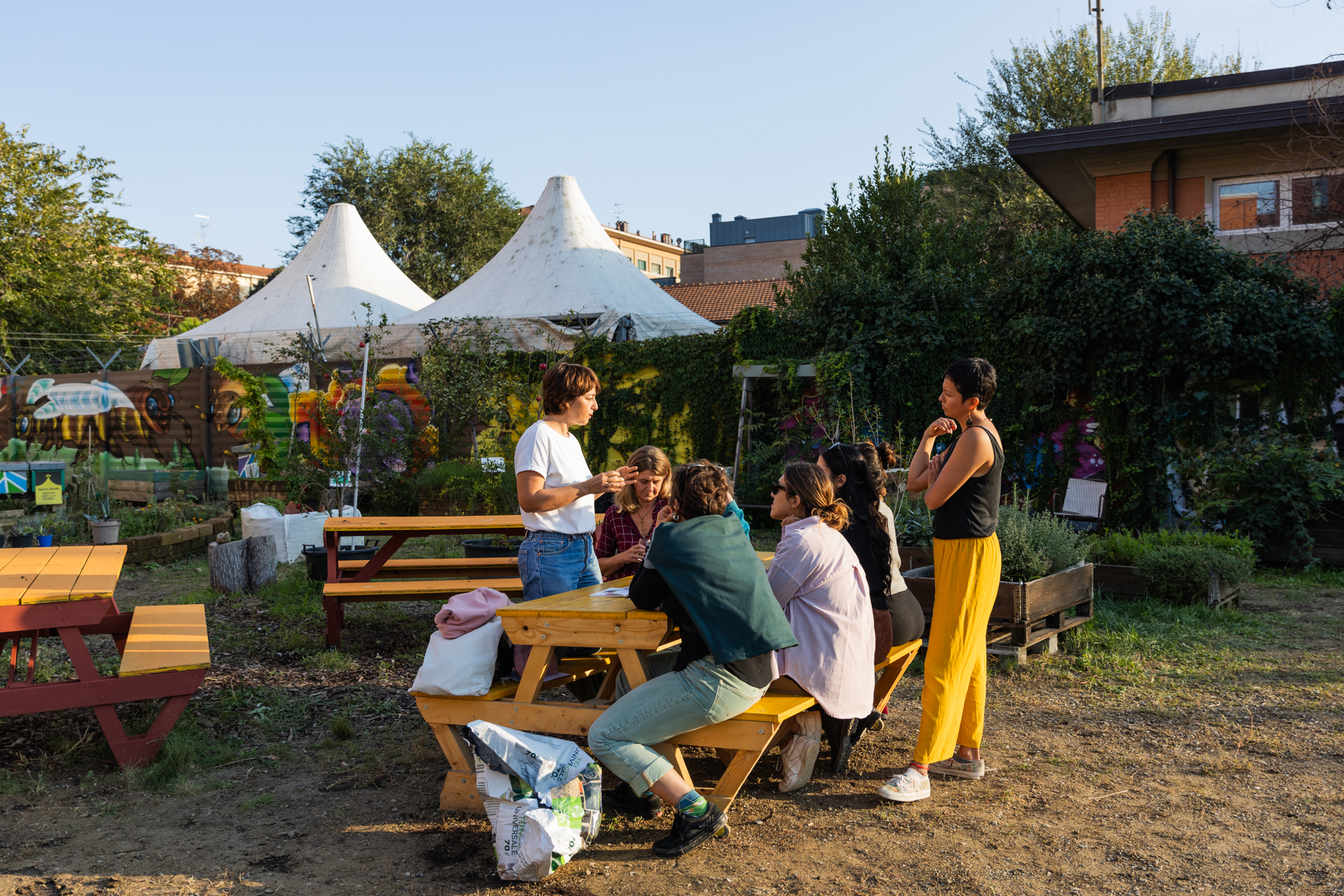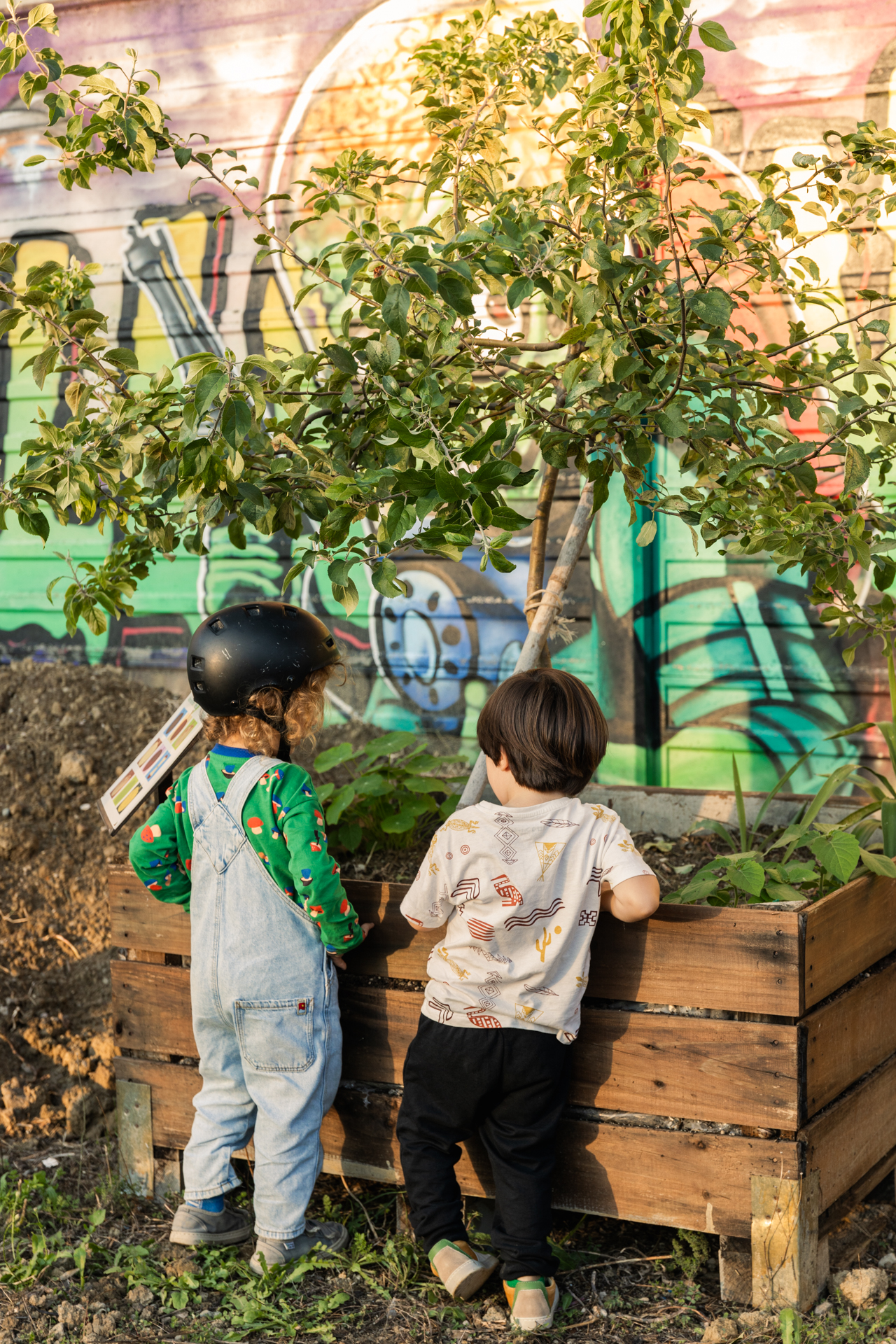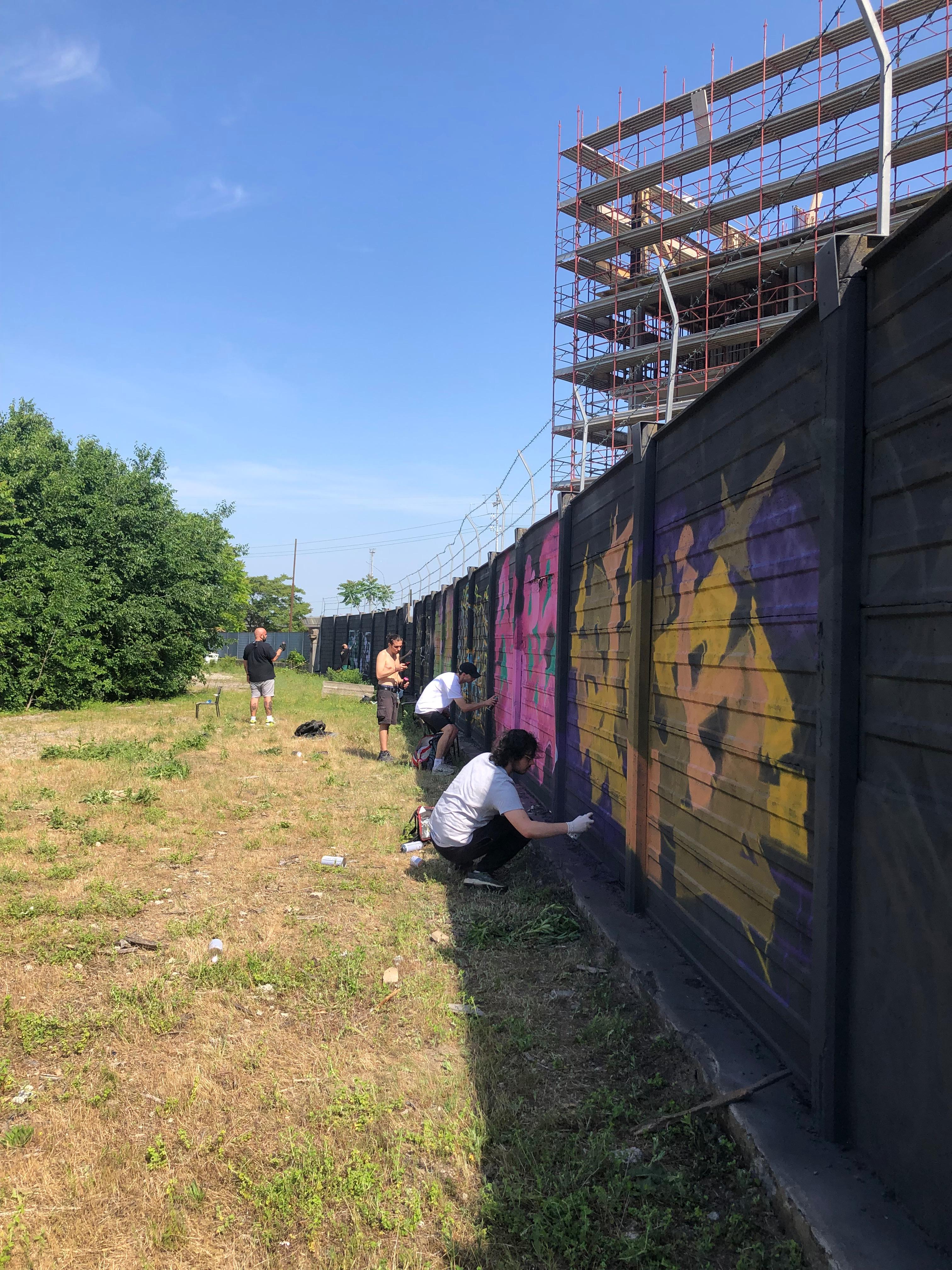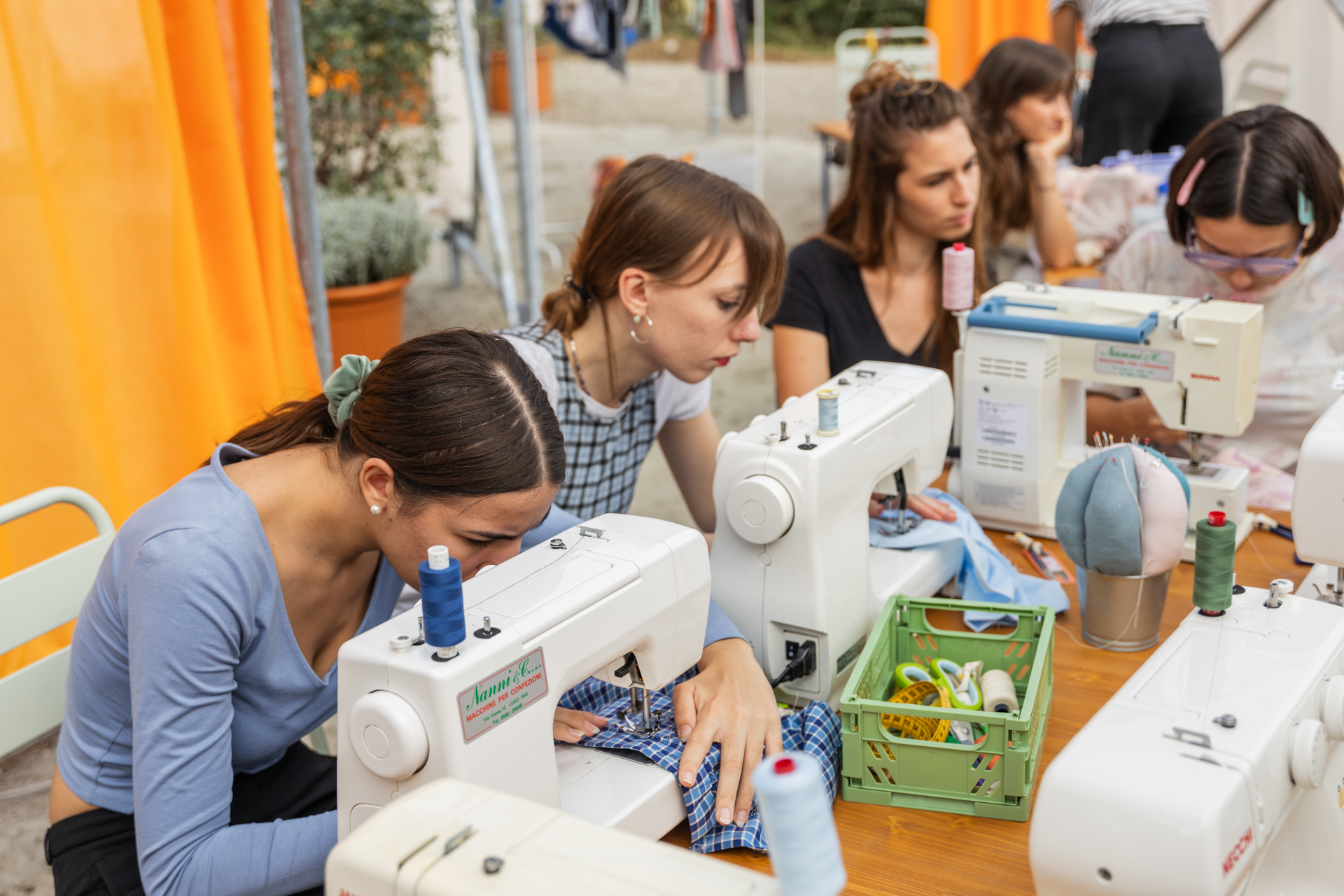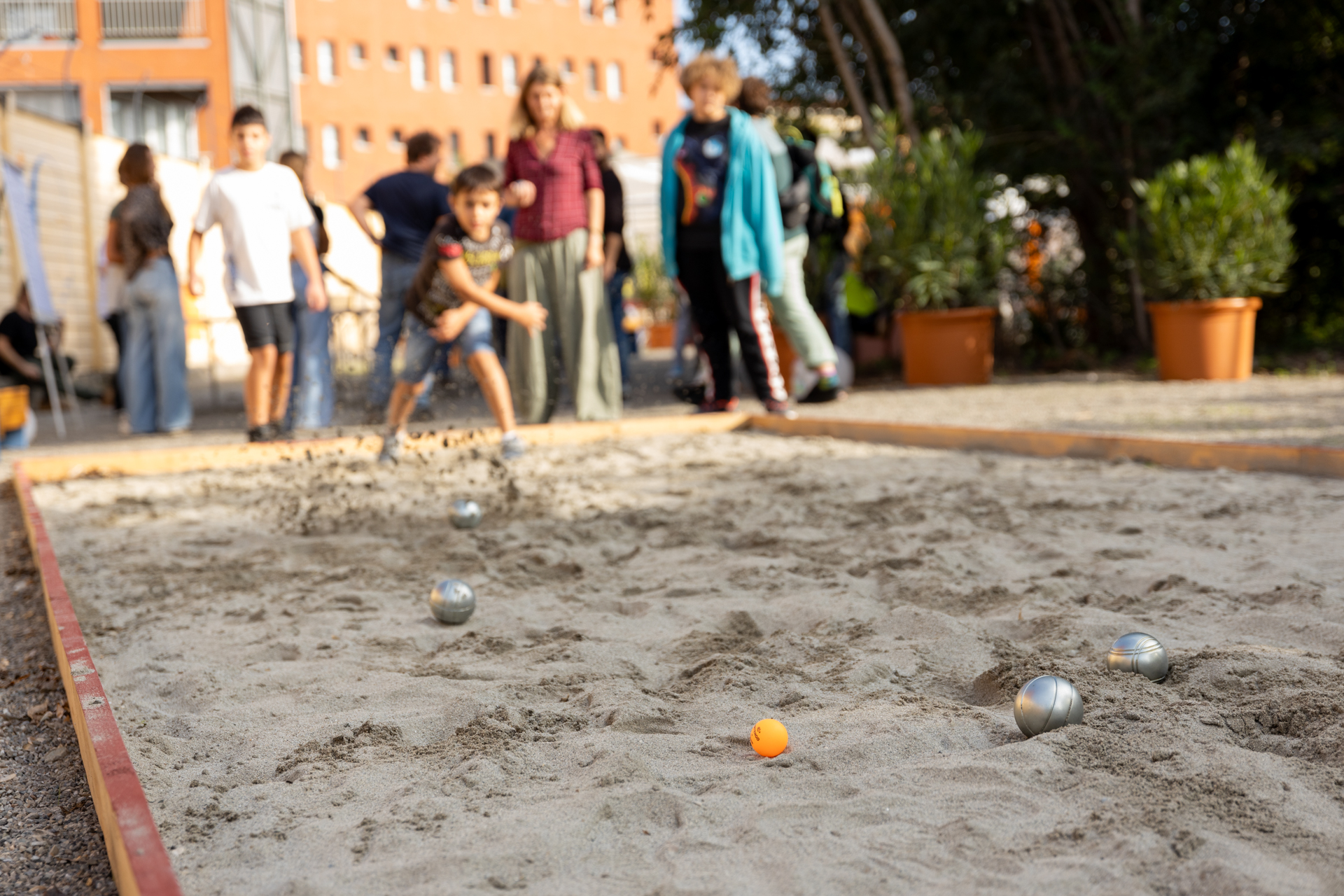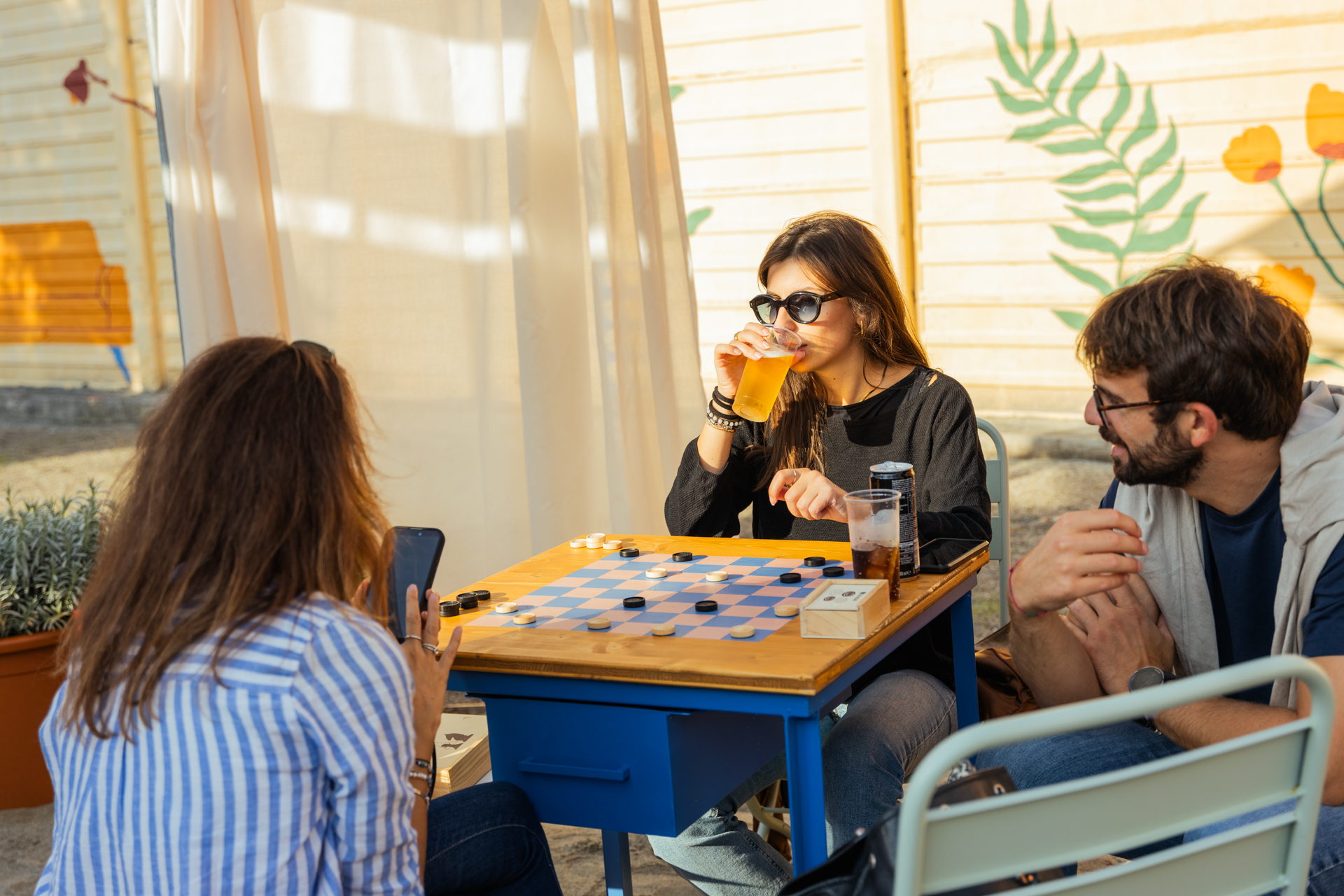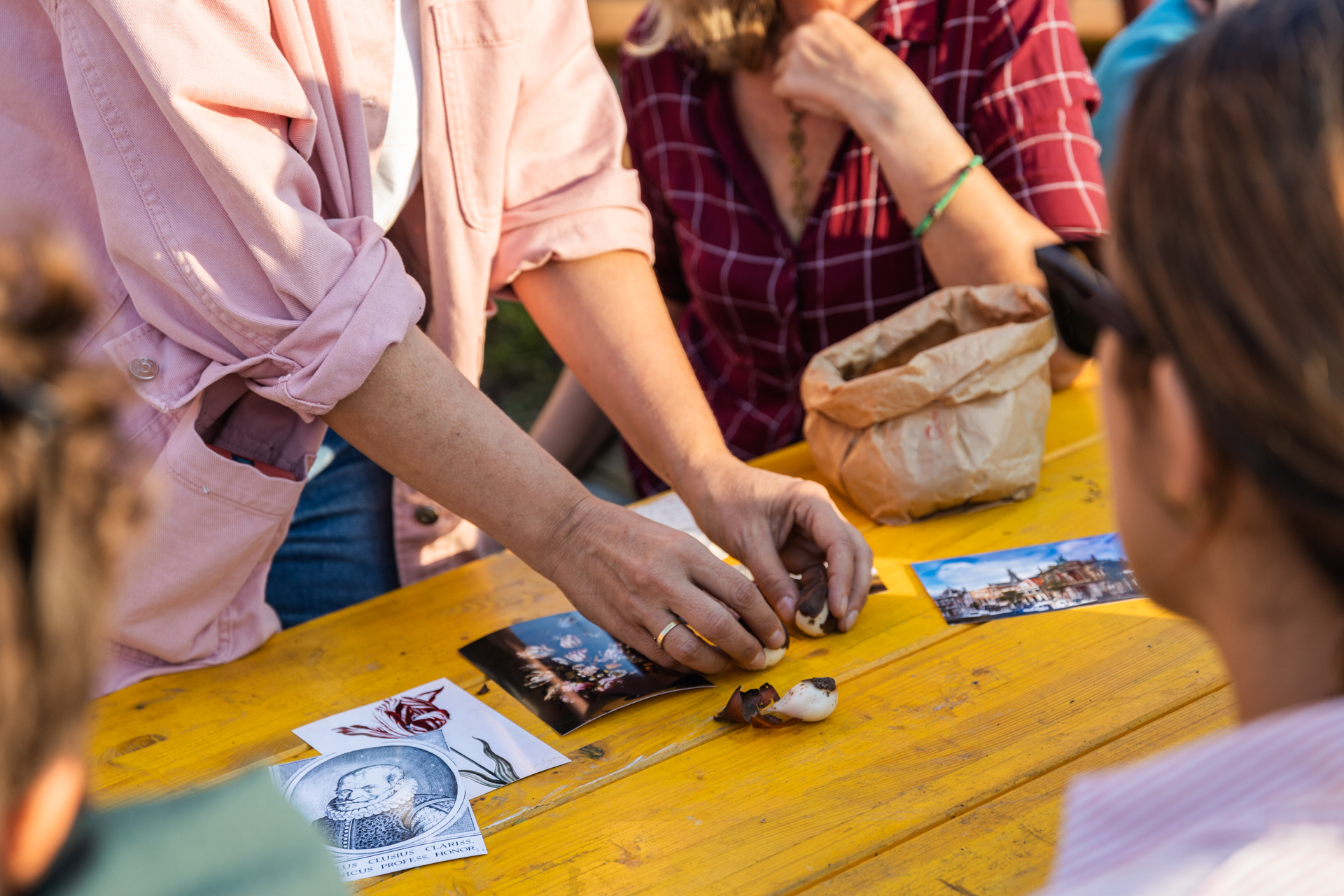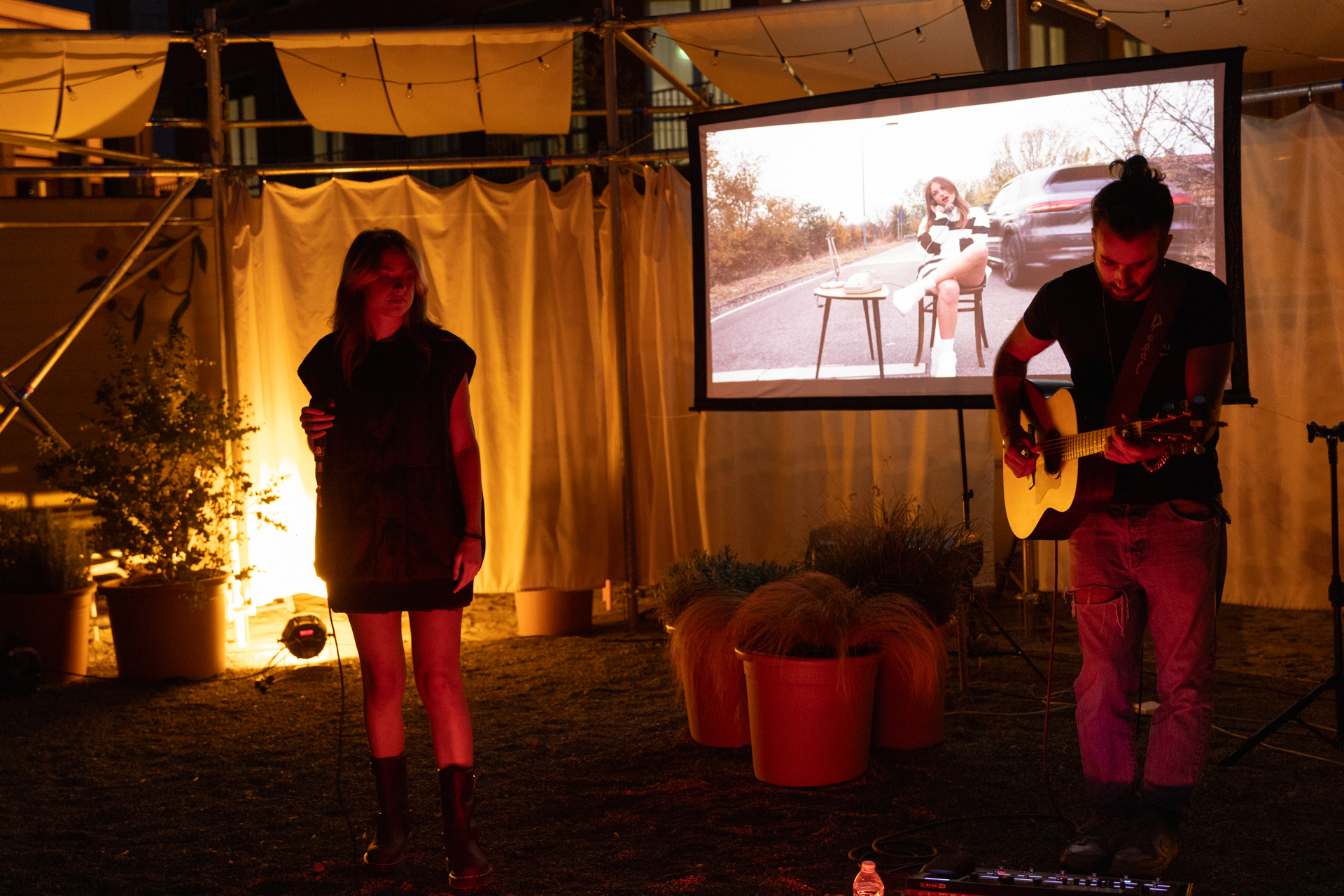Regaining a sense of belonging
P.Orto Urbano and Blocco Comune
P.Orto Urbano and Blocco Comune: dissemination spaces within DumBO built by the community
DumBO: an example of experimentation and reappropriation of the former Scalo Ferroviario Ravone of Bologna by the citizens.
Since 2022 its projects P.Orto Urbano and Blocco Comune have allowed the regeneration of a corner of the District, thanks to the active co-design from the bottom, creating a space for dissemination and sharing of sustainable practices, through an urban sandboxing approach.
Since 2022 its projects P.Orto Urbano and Blocco Comune have allowed the regeneration of a corner of the District, thanks to the active co-design from the bottom, creating a space for dissemination and sharing of sustainable practices, through an urban sandboxing approach.
Italy
Local
Bologna
Mainly urban
It refers to other types of transformations (soft investment)
Yes
2024-12-31
No
No
No
As a representative of an organisation
DumBO is a cultural and creative hub in Bologna that transformed a former railway yard abandoned in the 1990s into a dynamic urban and social space through an urban sandboxing approach.
In 2019, the birth of DumBO brought new life to the place, carrying out progressive regeneration and interventions to test new ways of reclaiming and reimagining urban space for the future.
The project aims to revitalize a disused area by fostering creative experimentation, community participation, and cultural innovation. The overall goal is to test and adapt urban solutions promoting sustainability, creativity, and social cohesion through temporary and flexible interventions, providing a platform for citizens to collaborate on urban transformation projects.
Some of DumBO's projects involving the community are: Blocco Comune, a space for the community and the neighbourhood, hosting a carpentry workshop and two rooms for communal use, to create synergies and disseminate skills with a peer-to-peer approach, towards topics related to handicrafts, sustainability, reuse of materials, and green cultivation. Every month it hosts an open assembly in which to bring new ideas, plan workshops and laboratories, common space care interventions and aggregation events. P.Orto Urbano is a project created to observe and reflect on the concept of nature in an urban context; hosting cultivated plants, pollinating insects, spontaneous vegetation and beehives. P.orto Urbano has encouraged the experimentation of practical solutions to environmental challenges, which can be easily reproduced by citizens on their own and thus stimulate small virtuous actions.
Along with these projects, every year DumBO organises a Call To Action to make DumBO's outdoor spaces available free of charge to realities that want to bring new content and develop entertainment, educational, cultural and social projects, enriching DumBO's cultural proposal with initiatives for experimentation and social interaction.
In 2019, the birth of DumBO brought new life to the place, carrying out progressive regeneration and interventions to test new ways of reclaiming and reimagining urban space for the future.
The project aims to revitalize a disused area by fostering creative experimentation, community participation, and cultural innovation. The overall goal is to test and adapt urban solutions promoting sustainability, creativity, and social cohesion through temporary and flexible interventions, providing a platform for citizens to collaborate on urban transformation projects.
Some of DumBO's projects involving the community are: Blocco Comune, a space for the community and the neighbourhood, hosting a carpentry workshop and two rooms for communal use, to create synergies and disseminate skills with a peer-to-peer approach, towards topics related to handicrafts, sustainability, reuse of materials, and green cultivation. Every month it hosts an open assembly in which to bring new ideas, plan workshops and laboratories, common space care interventions and aggregation events. P.Orto Urbano is a project created to observe and reflect on the concept of nature in an urban context; hosting cultivated plants, pollinating insects, spontaneous vegetation and beehives. P.orto Urbano has encouraged the experimentation of practical solutions to environmental challenges, which can be easily reproduced by citizens on their own and thus stimulate small virtuous actions.
Along with these projects, every year DumBO organises a Call To Action to make DumBO's outdoor spaces available free of charge to realities that want to bring new content and develop entertainment, educational, cultural and social projects, enriching DumBO's cultural proposal with initiatives for experimentation and social interaction.
Sandboxing
Urban Regeneration
Community Engagement
Co-design
Experimentation
The projects described were forged on the principles of environmental sustainability and self-sufficiency: all the activities proposed and the management of Blocco Comune, P.orto Urbano and DumBO’s venues have as their focus the experimentation and dissemination of sustainable practices.
Blocco Comune proposes activities to the community made for the most part with reutilised and second hand materials: a practice that is in harmony with the district, where the presence of temporary set-ups implies the existence of materials that can be transformed.
Creative upcycling and co-designing workshops are therefore proposed, for example, to reflect on and transform together the common spaces of DumBO, giving new ideas for the use of a collective urban space. In addition, DumBO spaces are furnished with recycled raw materials, open labs are held in which functional objects are created using simple machinery. A bycycle workshop service is activated weekly, where participants can bring their bikes and carry out repairs;
P.Orto Urbano is DumBO's regenerated green area: where initially there was only cement, now a real urban ecosystem has arisen, where care, maintenance and implementation activities are carried out with zero environmental impact. The project enhances the natural ability of plants to break down pollutants, while restoring unused soil and space for community use, transforming a marginal and decaying area into an active green hub.
Practically, the area has also become a space for dissemination of green knowledge and sustainable practices, bringing together associations and citizens, where people can self-produce gifts and DIY products as an alternative to a consumerist approach, such as beeswax products coming from P.Orto Urbano’s hives, terrariums, crocheted items, book and clothes swaps, etc.
Blocco Comune proposes activities to the community made for the most part with reutilised and second hand materials: a practice that is in harmony with the district, where the presence of temporary set-ups implies the existence of materials that can be transformed.
Creative upcycling and co-designing workshops are therefore proposed, for example, to reflect on and transform together the common spaces of DumBO, giving new ideas for the use of a collective urban space. In addition, DumBO spaces are furnished with recycled raw materials, open labs are held in which functional objects are created using simple machinery. A bycycle workshop service is activated weekly, where participants can bring their bikes and carry out repairs;
P.Orto Urbano is DumBO's regenerated green area: where initially there was only cement, now a real urban ecosystem has arisen, where care, maintenance and implementation activities are carried out with zero environmental impact. The project enhances the natural ability of plants to break down pollutants, while restoring unused soil and space for community use, transforming a marginal and decaying area into an active green hub.
Practically, the area has also become a space for dissemination of green knowledge and sustainable practices, bringing together associations and citizens, where people can self-produce gifts and DIY products as an alternative to a consumerist approach, such as beeswax products coming from P.Orto Urbano’s hives, terrariums, crocheted items, book and clothes swaps, etc.
Blocco Comune and P.Orto Urbano are two projects in which Form is neither decided nor a defined objective, but a constantly evolving element. The aesthetic beauty of the projects is a consequence of the fact that the spaces are gradually constructed and modified by those who live them. It is therefore not a defined and permanent shape, but one that is constantly mutating and evolving, supporting the contributions and temporary perspective of the people who carry out the projects.
P.Orto Urbano and Blocco Comune are two quality projects because, among the people working and collaborating in them, they also include experts in green care and craftsmanship. All projects therefore have a peer-to-peer approach in terms of planning, developing ideas for the transformation of DumBO's places and carrying out the interventions, but still have reference figures who work professionally in the fields in question. This ensures that the quality level of the workshops and project management is always high and that state-of-the-art solutions and interventions are proposed.
Both of the projects described above propose innovative visions and practices, in which the figures working in them and representing them experiment with pioneering but still uncommon practices: for example, social carpentry, or a more analytical approach to green spaces inherent to studies around the Third Landscape.
P.Orto Urbano and Blocco Comune are two quality projects because, among the people working and collaborating in them, they also include experts in green care and craftsmanship. All projects therefore have a peer-to-peer approach in terms of planning, developing ideas for the transformation of DumBO's places and carrying out the interventions, but still have reference figures who work professionally in the fields in question. This ensures that the quality level of the workshops and project management is always high and that state-of-the-art solutions and interventions are proposed.
Both of the projects described above propose innovative visions and practices, in which the figures working in them and representing them experiment with pioneering but still uncommon practices: for example, social carpentry, or a more analytical approach to green spaces inherent to studies around the Third Landscape.
DumBO and its projects are a model of urban regeneration that aim to continuously improve its parameters of accessibility and inclusiveness, thanks to a flexible, participatory and inclusive approach.
In fact, all DumBO locations are free of physical barriers and inclusive for all types of users. Blocco Comune is open to the community and the neighbourhood, to create synergies, disseminate skills with a peer-to-peer approach towards topics related to crafts, sustainability and reuse of materials. Every month, Blocco Comune hosts an open assembly in which to develop new ideas. All the activities coming from Blocco Comune are free of charge or free offer.
P.Orto Urbano is also open to all citizens: the Building Up activities spread practices stimulating small virtuous actions. Each proposed activity is again free of charge. June 2024 also saw the inauguration of P.Orto Urbano Digitale, a project that led to the creation of digital content to narrate and highlight the project's features, thanks to animations and audio narratives coming from installed plaques. This broadened the user base of P.Orto Urbano, thus making it more accessible.
Even in the annual Call To Action, the open-air spaces of DumBO are made available for free, giving the possibility of having a space in which to start up activities, also to emerging realities and private individuals who do not carry out their proposals by profession. This ensures the presence of experimental and non-profit activities at DumBO. Finally, there are projects aiming to break down other types of barriers that people with disabilities might meet: bar staff at public events are trained in sign language (LIS); workshops and seminars offered have often hosted and included groups from disadvantaged communities/with physical and cognitive disabilities; and finally, DumBO has hosted seven internships and work placements of disadvantaged people since 2022, one of whom has become a permanent staff member.
In fact, all DumBO locations are free of physical barriers and inclusive for all types of users. Blocco Comune is open to the community and the neighbourhood, to create synergies, disseminate skills with a peer-to-peer approach towards topics related to crafts, sustainability and reuse of materials. Every month, Blocco Comune hosts an open assembly in which to develop new ideas. All the activities coming from Blocco Comune are free of charge or free offer.
P.Orto Urbano is also open to all citizens: the Building Up activities spread practices stimulating small virtuous actions. Each proposed activity is again free of charge. June 2024 also saw the inauguration of P.Orto Urbano Digitale, a project that led to the creation of digital content to narrate and highlight the project's features, thanks to animations and audio narratives coming from installed plaques. This broadened the user base of P.Orto Urbano, thus making it more accessible.
Even in the annual Call To Action, the open-air spaces of DumBO are made available for free, giving the possibility of having a space in which to start up activities, also to emerging realities and private individuals who do not carry out their proposals by profession. This ensures the presence of experimental and non-profit activities at DumBO. Finally, there are projects aiming to break down other types of barriers that people with disabilities might meet: bar staff at public events are trained in sign language (LIS); workshops and seminars offered have often hosted and included groups from disadvantaged communities/with physical and cognitive disabilities; and finally, DumBO has hosted seven internships and work placements of disadvantaged people since 2022, one of whom has become a permanent staff member.
Citizens have been central to the success and development of DumBO and its projects, with their involvement shaping the project at every stage. DumBO has adopted a participatory approach, inviting local residents, community groups, and cultural organizations to actively engage in the design and development of the district. Workshops, public consultations, and collaborative events have been organized to gather feedback, ideas, and ensure that the needs and aspirations of the community are met. This co-creation process has empowered citizens to directly influence the shaping of this urban space, fostering a sense of ownership and connection towards an urban space that has existed in the neighbourhood for decades but never been part of the citizen’s life.
Local residents and cultural groups are not just passive beneficiaries but play an active role in the programming of activities and labs. From sewing and crochet workshops to cultivation, gardening and ecosystems design workshops, plastic upcycle labs, screen printing, clay modelling workshops, book presentations and screenings of independent short films
These activities have often been made from local individuals and associations, which contributed their time and skills through volunteering, creating networks of support and exchange, strengthening social ties within the community. Relationships with schools have also intensified, where once it was mainly guided tours, now there is a commitment to weaving continuity projects.
Furthermore, P.Orto Urbano is committed to weaving relations with other green spaces in the neighbourhood, to intensify citizen involvement
This approach has ensured DumBO not just a top-down urban development, but an engagement that fostered a sense of pride and belonging, where different background, ideas, and voices can thrive.
Local residents and cultural groups are not just passive beneficiaries but play an active role in the programming of activities and labs. From sewing and crochet workshops to cultivation, gardening and ecosystems design workshops, plastic upcycle labs, screen printing, clay modelling workshops, book presentations and screenings of independent short films
These activities have often been made from local individuals and associations, which contributed their time and skills through volunteering, creating networks of support and exchange, strengthening social ties within the community. Relationships with schools have also intensified, where once it was mainly guided tours, now there is a commitment to weaving continuity projects.
Furthermore, P.Orto Urbano is committed to weaving relations with other green spaces in the neighbourhood, to intensify citizen involvement
This approach has ensured DumBO not just a top-down urban development, but an engagement that fostered a sense of pride and belonging, where different background, ideas, and voices can thrive.
DumBO is also a place where the interests of institutions converge. In fact, the success of DumBO was built on a strong collaboration with a wide range of stakeholders at different levels, ensuring a holistic and sustainable approach to its design and implementation.
Their involvement ensured that the project aligned with the city's development strategies, including the sustainability goals from the Climate 2030 Mission, of which Bologna is a member, and community engagement.
The municipality, the regional government, and other institutions - such as Fondazione per l’Innovazione Urbana, the University Of Bologna and social cooperatives - provided support through co-planning and resources, recognizing DumBO as an important cultural and social hub: their involvement allowed DumBO to expand its impact beyond the local level, positioning it as a key player in the development of creative industries. Furthermore, local citizens, neighborhood, associations, and cultural groups were key collaborators, actively contributing to the planning, design, and programming of DumBO.
Finally, DumBO was also supported by European funding initiatives promoting urban regeneration, cultural innovation, and sustainability. By participating in EU programs, DumBO aligned with broader European objectives related to sustainable urban development, cultural heritage, and social cohesion. The involvement of EU bodies further enhanced the project’s sustainability and replicability, positioning DumBO as a model for other European cities and regenerable areas. The collective engagement also facilitated cross-sectoral collaboration, bringing together urban planners, cultural organizations, policymakers, and citizens in a unified effort to transform the urban space.
In sum, the diverse stakeholder involvement and the collaboration between public and private bodies ensured DumBO’s relevance, sustainability, and success, making it a powerful example of collaborative urban regeneration.
Their involvement ensured that the project aligned with the city's development strategies, including the sustainability goals from the Climate 2030 Mission, of which Bologna is a member, and community engagement.
The municipality, the regional government, and other institutions - such as Fondazione per l’Innovazione Urbana, the University Of Bologna and social cooperatives - provided support through co-planning and resources, recognizing DumBO as an important cultural and social hub: their involvement allowed DumBO to expand its impact beyond the local level, positioning it as a key player in the development of creative industries. Furthermore, local citizens, neighborhood, associations, and cultural groups were key collaborators, actively contributing to the planning, design, and programming of DumBO.
Finally, DumBO was also supported by European funding initiatives promoting urban regeneration, cultural innovation, and sustainability. By participating in EU programs, DumBO aligned with broader European objectives related to sustainable urban development, cultural heritage, and social cohesion. The involvement of EU bodies further enhanced the project’s sustainability and replicability, positioning DumBO as a model for other European cities and regenerable areas. The collective engagement also facilitated cross-sectoral collaboration, bringing together urban planners, cultural organizations, policymakers, and citizens in a unified effort to transform the urban space.
In sum, the diverse stakeholder involvement and the collaboration between public and private bodies ensured DumBO’s relevance, sustainability, and success, making it a powerful example of collaborative urban regeneration.
DumBO and its projects involved a multidisciplinary approach, integrating diverse knowledge fields that made the urban regeneration process well-rounded and innovative.
Representatives from the cultural and creative sectors — including artists, event agencies, recycling and environmental companies, architects, communication companies and cultural managers—brought a wealth of knowledge regarding how to animate public spaces and engage the community.
Through their work, DumBO became a platform for cultural expression and exchange, generating a vibrant atmosphere that continuously evolves. Furthermore, the identification of a sustainability manager and a collaboration with the University Of Bologna - creating a tool measuring the environmental impacts of activities - ensured that DumBO’s transformation adhered to ecological principles.
The versatility of the project is also reflected in the cooperation between the private sector (the firms/cooperative involved in the management) and the public institution (the Municipality of Bologna) interested in experimenting an innovative temporary use for the Ravone district. After that, a mixed governance gathered around the same objectives, putting together the tenant and other stakeholders (social and cultural partners, entrepreneurs and neighborhood).
In order to create a more complete offer and address issues and skills with a transversal approach, many of the associations operating at DumBO have also created collaborations among themselves. The combination of several realities operating in the world of sustainability or greenery has thus led to innovative and unexpected outcomes.
Representatives from the cultural and creative sectors — including artists, event agencies, recycling and environmental companies, architects, communication companies and cultural managers—brought a wealth of knowledge regarding how to animate public spaces and engage the community.
Through their work, DumBO became a platform for cultural expression and exchange, generating a vibrant atmosphere that continuously evolves. Furthermore, the identification of a sustainability manager and a collaboration with the University Of Bologna - creating a tool measuring the environmental impacts of activities - ensured that DumBO’s transformation adhered to ecological principles.
The versatility of the project is also reflected in the cooperation between the private sector (the firms/cooperative involved in the management) and the public institution (the Municipality of Bologna) interested in experimenting an innovative temporary use for the Ravone district. After that, a mixed governance gathered around the same objectives, putting together the tenant and other stakeholders (social and cultural partners, entrepreneurs and neighborhood).
In order to create a more complete offer and address issues and skills with a transversal approach, many of the associations operating at DumBO have also created collaborations among themselves. The combination of several realities operating in the world of sustainability or greenery has thus led to innovative and unexpected outcomes.
DumBO and its project can be interpreted as an interesting example of urban sandboxing: an approach to urban planning that focuses on temporary experimentation and low-risk, but high-potential interventions. DumBo is a model urban laboratory, where creative and alternative solutions for the development, management and use of a public space are tested. In this way, the district becomes a ‘playground’ where the active contributions of PPPs (People-Public-Private) converge and non-traditional possibilities for the rehabilitation and enhancement of disused urban areas are explored. For example, events, workshops, courses, art installations, markets and other activities are organised to quickly transform the space, creating constant interaction with citizens and stimulating re-appropriation of the place.
Furthermore, the design of the spaces is flexible, allowing different initiatives to be implemented, without having to wait for a definitive and rigid planning.
Given its dimensions (the overall size of the district is 40,000 square metres), it welcomes different experiences and, while respecting the history and characteristics of each one, brings them together to create new synergies and share a vision. DumBO District is an open, cross-sectoral community that constantly creates new connections between culture, art and society.
Furthermore, the design of the spaces is flexible, allowing different initiatives to be implemented, without having to wait for a definitive and rigid planning.
Given its dimensions (the overall size of the district is 40,000 square metres), it welcomes different experiences and, while respecting the history and characteristics of each one, brings them together to create new synergies and share a vision. DumBO District is an open, cross-sectoral community that constantly creates new connections between culture, art and society.
The presence of various activities and events inevitably implies the involvement of a multiplicity of disciplines and partners. This makes the approach transdisciplinary, based on a stable community of people gathered around the project, with various knowledge, experiences and skills.
The activities and spaces, which at Blocco Comune and P.Orto Urbano are offered on a non-profit basis, involve a sharing of materials between the various realities and made available by the space. This is to encourage the reuse and recycling of materials and working methods with zero environmental impact and the lowest possible consumption of materials and energy.
The methodology used is based on the dissemination of knowledge and skills in an open environment free from limits imposed by potential risks, freely allowing experimentation, failure, variation, making everyone an active contributor to the project and participate in the whole process.
The activities and spaces, which at Blocco Comune and P.Orto Urbano are offered on a non-profit basis, involve a sharing of materials between the various realities and made available by the space. This is to encourage the reuse and recycling of materials and working methods with zero environmental impact and the lowest possible consumption of materials and energy.
The methodology used is based on the dissemination of knowledge and skills in an open environment free from limits imposed by potential risks, freely allowing experimentation, failure, variation, making everyone an active contributor to the project and participate in the whole process.
DumBO is an open-ended project: this has meant that every structural and design intervention has been conditioned by its temporary nature. This has accentuated the experimental and transitory character of the interventions in each of its declinations, while at the same time making it a strong point, precisely because the various projects born at DumBO have a strong capacity to be replicated and thus re-proposed in other circumstances.
The methodology underlying the DumBO projects can be reproposed from several points of view: from the point of view of governance and the flow of proposals from below, through assemblies and open calls; regenerated green spaces can serve as a model for the redevelopment of other areas, as they are created through natural factors present in other contexts: spontaneous greenery, cultivated plants and pollinating insects.
Often, the context proposed to the realities involves recycling and sharing of materials, stimulating the ability to reinvent oneself and adapt to the starting situation.
DumBO, in its entirety, can therefore be considered a temporary project that serves as a model of urban regeneration that can be transferred to other contexts, given its versatility and adaptability.
The methodology underlying the DumBO projects can be reproposed from several points of view: from the point of view of governance and the flow of proposals from below, through assemblies and open calls; regenerated green spaces can serve as a model for the redevelopment of other areas, as they are created through natural factors present in other contexts: spontaneous greenery, cultivated plants and pollinating insects.
Often, the context proposed to the realities involves recycling and sharing of materials, stimulating the ability to reinvent oneself and adapt to the starting situation.
DumBO, in its entirety, can therefore be considered a temporary project that serves as a model of urban regeneration that can be transferred to other contexts, given its versatility and adaptability.
DumBO reproduces innovative practices at scale, constituting a key player among the authors of a globally necessary change.
The areas in which DumBO and its projects intervene mainly concern: urban regeneration, community building, and sustainable development.
A problem faced by many cities is that of abandoned or underutilised spaces, which can lead to urban decay, reduced quality of life, and missed economic opportunities. DumBO transformed a 40,000sqm area that had been abandoned for years and was only to be demolished for the construction of new buildings into a cultural and multifunctional space with great social value.
This urban regeneration provided a sustainable approach to revitalising urban spaces without expanding the urban footprint. By reusing existing infrastructure, DumBO reduced the need for new construction, thereby helping to conserve resources and reduce environmental impact.
Furthermore, cultural and creative sectors globally struggle to thrive due to lack of space, funding, or support. This limits opportunities for local artists, creators, associations, and social initiatives that would not usually have the means to bear the costs of spaces.
DumBO - thanks to its diversified support - acts as a bridge for a vast category of culturally fundamental realities that are unable to find support and economic equilibrium on a global level. Concretely, this translates into the possibility of providing spaces and activities free of charge, to associations and cultural realities that are fundamental for the collectivity, but globally cannot find a total economic support. This provides concrete support to local artists, performers, and cultural projects; it encourages the growth of the creative economy, providing areas to social activities and workshops.
Finally, in its own small way, DumBO offers sustainable practices combined with the hundreds of events and activities it hosts each year.
The areas in which DumBO and its projects intervene mainly concern: urban regeneration, community building, and sustainable development.
A problem faced by many cities is that of abandoned or underutilised spaces, which can lead to urban decay, reduced quality of life, and missed economic opportunities. DumBO transformed a 40,000sqm area that had been abandoned for years and was only to be demolished for the construction of new buildings into a cultural and multifunctional space with great social value.
This urban regeneration provided a sustainable approach to revitalising urban spaces without expanding the urban footprint. By reusing existing infrastructure, DumBO reduced the need for new construction, thereby helping to conserve resources and reduce environmental impact.
Furthermore, cultural and creative sectors globally struggle to thrive due to lack of space, funding, or support. This limits opportunities for local artists, creators, associations, and social initiatives that would not usually have the means to bear the costs of spaces.
DumBO - thanks to its diversified support - acts as a bridge for a vast category of culturally fundamental realities that are unable to find support and economic equilibrium on a global level. Concretely, this translates into the possibility of providing spaces and activities free of charge, to associations and cultural realities that are fundamental for the collectivity, but globally cannot find a total economic support. This provides concrete support to local artists, performers, and cultural projects; it encourages the growth of the creative economy, providing areas to social activities and workshops.
Finally, in its own small way, DumBO offers sustainable practices combined with the hundreds of events and activities it hosts each year.
Five years after the birth of DumBO and two years after Blocco Comune and P.Orto Urbano, each project has contributed in its own way to gradually generating an active and participatory re-appropriation of an abandoned neighbourhood space. This has triggered the creation of an ecosystem of relations made up of more than 150 activities on the part of about 30 actors of various types: those who collaborate directly in the initiative by actively carrying out actions or even co-managing the space; those to whom the space is made available for their own activities, contributing to animating it and experimenting with different uses; those who have acted as sponsors by giving financial support; other realities that recognise it as a place of interest, such as schools coming to carry out educational activities, or research bodies.
The projects have also brought benefits, in a collateral manner, to other subjects who had ‘passively’ witnessed the redevelopment of the area, but who now experience and actively benefit from it: DumBO workers, elderly people, families now have a collective green space within a neighbourhood where green areas are scarce.
Finally, the existence of P.Orto Urbano and Blocco in any case triggered an increased interest in the neighbouring areas, which were in turn redeveloped while maintaining the predominant social gathering nature of the area.
The projects have also brought benefits, in a collateral manner, to other subjects who had ‘passively’ witnessed the redevelopment of the area, but who now experience and actively benefit from it: DumBO workers, elderly people, families now have a collective green space within a neighbourhood where green areas are scarce.
Finally, the existence of P.Orto Urbano and Blocco in any case triggered an increased interest in the neighbouring areas, which were in turn redeveloped while maintaining the predominant social gathering nature of the area.

